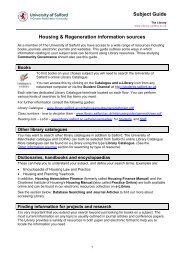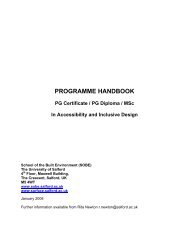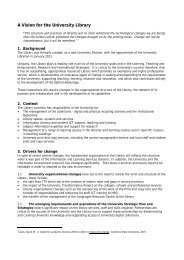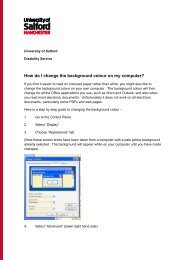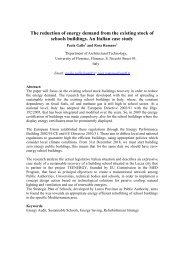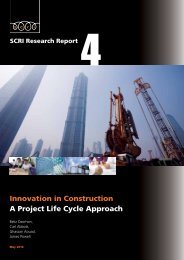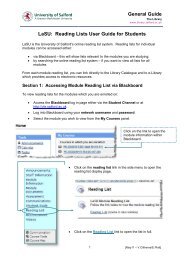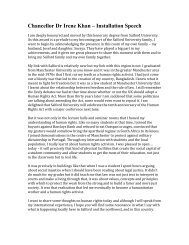Dry-lining versus a hemp and lime insulating render - University of ...
Dry-lining versus a hemp and lime insulating render - University of ...
Dry-lining versus a hemp and lime insulating render - University of ...
Create successful ePaper yourself
Turn your PDF publications into a flip-book with our unique Google optimized e-Paper software.
Where U errQ , U errTns <strong>and</strong> U errTout are the U‐values calculated when applying all errors dueto heat flux, internal surface temperature <strong>and</strong> external temperature, respectively <strong>and</strong> U isthe original U-value3.4 WUFI modelThe interstitial moisture control modelling investigation was developed in the moisture<strong>and</strong> heat transfer programme WUFI, from Fraunh<strong>of</strong>er Insitut. The full development <strong>of</strong>the models is covered previously (Flower, 2011). Two models were based on the twowall sections (Fig 1) <strong>and</strong> extended simulations performed. The first 10 months <strong>of</strong>recorded data from the cottage provided verification <strong>of</strong> the models ability toqualitatively represent the patterns <strong>of</strong> RH <strong>and</strong> temperature fluctuations (Fig 2).Figure 2: Simulated Data (red) <strong>versus</strong> real data (blue) in the 36mm mineral wool showing how thegeneral trends are well captured by the model4 Findings <strong>and</strong> discussionFigure 3 shows that the temperature gradient across the DL wall is steepest over theinsulation whereas the <strong>hemp</strong> appears to acting as if homogenous. On the warmest daythe external <strong>and</strong> internal temperature are both higher than the inside the centre <strong>of</strong> thewall by 5-6 o C <strong>and</strong> thus heat will be being drawn into the wall from the inside <strong>and</strong>outside surfaces whereas steady state would only predict a minor flow from outside toinside.From figure 4 it is evident that in both test walls, condensing moisture has beenoccurring constantly in both warm <strong>and</strong> cold conditions. This should be expected in theHemp/Lime wall as the materials are still drying. However the construction <strong>of</strong> the DLwas dry <strong>and</strong> despite the Vapour Barrier the RH behind the DL is constantly ~100% <strong>and</strong>has been so for the entire period <strong>of</strong> data collection suggestive the moisture is beingdrawn into the space from the slate wall.The conditions behind the DL test wall are as predicted <strong>and</strong> as the moisture presentcannot re-evaporate back into the interior environment as it can through theHemp/Lime, it must penetrate the thick stone masonry in order to escape, thusincreasing the risk <strong>of</strong> frost damage to the masonry, interstitial rot <strong>and</strong> mould growth.4.1 Embodied CarbonTables 1, 2 <strong>and</strong> 3 in figure 5 summarise the embodied carbon calculations for <strong>hemp</strong>crete7



